More than 600 different kinds of accessory pits have been found by archaeological workers up to now around the Qin Shi Huang Mausoleum. Besides the main three pits of Terracotta Army, the experts also discovered civil official figures, bronze aquatic birds, stone armor and helmets, and acrobatics figures in these accessory pits, as well as others like builders' graveyards, slaughter pits, and stable pits. All of these accessory pits reflect the Emperor Qin Shi Huang's idea of treating death as afterlife, who wanted to bring anything he had when alive to the afterworld so he could continue his luxurious life, and this idea was gradually adopted by emperors in later dynasties.
Below are the ones have been excavated. Among them, Pit K0006 and Pit K9901 are open to the public now, while the others are still closed, but tourists can see their unearthed relics on the Exhibition Hall of Historical Relics of Emperor Qin Shihuang's Mausoleum. Admission is included in the through ticket for the Terracotta Army.
During the process of exploration on Mausoleum of the First Qin Emperor, Pit K0006 was found in 2000, located to the southwestern corner of the mausoleum mound. It stretches from east to west with a total area of about 410 square meters (490 square yards). Looking like a Chinese character “中”, Pit K0006 consists of three parts: slope gateway, front pit and back pit. After elaborative excavation, archaeologists found some recognizable wooden materials including shelter, door board and floor. Civil official figures pit is the only unburnt accessory pit.
Inside the front pit, there are terrines and bronze weapons, and 12 pottery figures which are divided into 8 civil officials and 4 charioteer figures. All of the distinctive pottery figures wear long crowns to show their various ranks of nobility. The back pit is used to bury horses. According to density of those remaining bones, people can reckon that more than 20 horses were interred in the back pit. Besides, a single-axle wooden carriage with dual wheels is unearthed in the porch of the slope gateway.
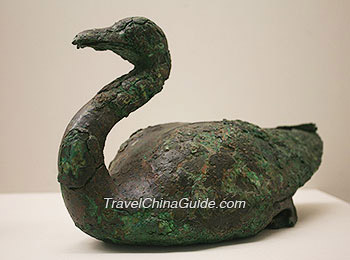 | | Bronze Duck | | 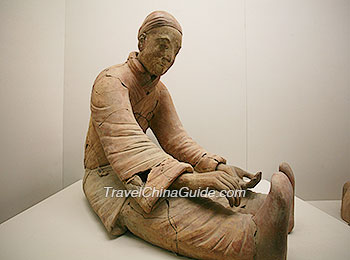 | | Terracotta Aquatic Birds Feeder | |
Flat shape of Pit K0007 is an English capital letter "F". Covering 978 square meters (1,170 square yards), this pit is divided into three districts. To the south of Pit K0007, District Ⅰ encompasses a number of rare bronze relics and aquatic birds. District Ⅱ is special because it’s constructed with 11 same habitacle. 15 terracotta figures were put in this district, and their work could be to domesticate those aquatic birds. In addition, there are a total of 6 cranes, 20 swan geese and 20 wild geese discovered in District Ⅰ and Ⅲ severally.
The bronze relics and aquatic birds pit is built to provide entertainment for Qin Shi Huang in his afterlife. In some ways, it is deemed to be the royal garden of
Qin Dynasty (221 BC – 207 BC).
Measuring 130 meters (142 yards) long, 100 meters (109 yards) wide, Pit K9801 is the largest one within the walls of Qin Shi Huang Mausoleum. A large amount of stone armor and helmets are excavated from this pit, including 87 pieces of armor, 43 helmets and 3 bridle reins. They will be valuable thorough data for researching the armor of Qin because the excavation can fill the gap in the history of archaeology for Qin Dynasty.
These discovered armor and helmets are elaborately made and adopt jade processing technology at that time to be burial objects for the First Emperor of Qin.
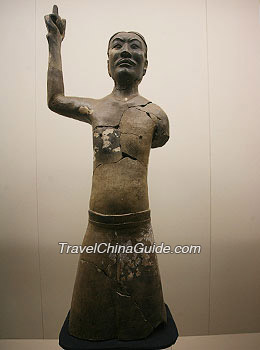 |
| Acrobatic Figure |
Pit K9901 situates in the southeast of Qin Shi Huang’s Mausoleum between the inner city and outer city. The pit is also called Acrobatics Figures Pit because it contains 11funny pottery figures imitating the acrobatics figures of Han Dynasty (202 BC – 220). As special burial objects, these discovered acrobatics figures neither wear armor nor robe, only have trousers with their half-naked bodies. It is worth mentioning that a 61-centimeter (24 inches) tall, 212-kilogram (467 pounds) weight bronze tripod was discovered in this pit as well, which is considered as an instrument for performing. With beautifully shaped appearance, it is regarded as the largest one found in Qin’s cultural site so far.
Based on current state of excavation in Pit K9901, archaeologists think that there may be some bronze wares, chariots and horses buried underground in this pit.
In 1980, two colored bronze chariots and horses were excavated from a pit. They are the biggest and best-preserved bronze carriages found in Chinese archaeological history, hence they can provide great value to study ancient bronze manufacturing technology and vehicle structures. Both of the single-shaft carriages have two wheels equipped with four horses. Their excavation offers people an opportunity to see the real appearance of ancient royal carriage. Tourists can see the fancy painted pattern on the carriages. Besides, 14-kilogram (31-pound) gold and silver decorations on their bodies also demonstrate its nobility.
Builder's Graveyards
The builder's graveyards are located about 1.5 kilometers (1 mile) southwest to the Mausoleum of the Emperor Qin Shi Huang. Covering an area of 8,100 square meters (9,688 square yards), the graveyard contains 114 graves including 106 Qin graves and some Han and Tang graves. The graves are quite crowded together, with some arranged at intervals as small as 18 centimeters (7 inches). In 1980, 32 Qin graves were excavated. They were all rectangular in shape. The smallest one measures 80 centimeters (31 inches) long and 65 centimeters (26 inches) wide. Such a narrow pit is rare to see in Qin tombs. Moreover, it is astonishing that over 100 skeletons were squeezed into these 32 graves. Examination proved that most of the dead were young males. A man, a woman and a child, possibly a family forced to labor for the Qin government, were found buried together in one grave. The heads of all the skeletons were facing different directions, indicating a hasty burial at that time. Some heads had clear stab wounds, which showed that their owners were barbarously killed after they built the Qin Mausoleum.
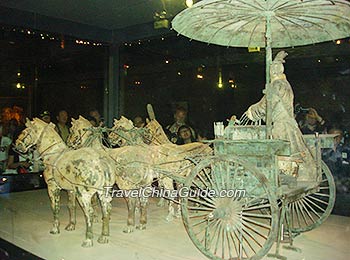 | | Bronze Chariots and Horses | | 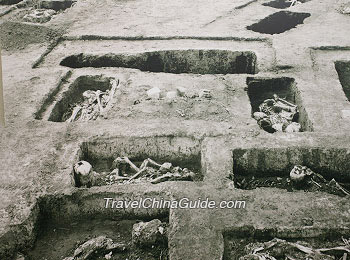 | | Builders' Graveyard | |
Stable Pits
Discovered in 1976, there are two sites containing stable pits. One is to the east of the Mausoleum Mound of the Emperor Qin Shi Huang, and the other lies between the inner and outer walls of the mausoleum. Archaeologists have discovered 98 stable pits in the first site. They are distributed neatly in three lines from north to south. Some burial pits contained a single horse, while in others only a statue of a kneeling terracotta figure was found. Others have both. The horses are believed to have been buried alive because the four limbs appear to be struggling and traces of restraining straps can be seen. Pottery and basins to feed the horses had been put in front of the horse heads.
Slaughter Pits
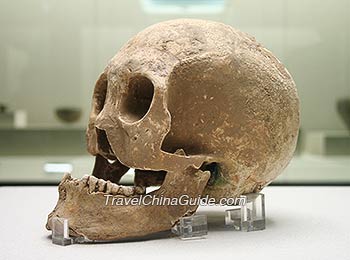 |
| Skull from Slaughter Pits |
There are 17 slaughter pits located about 5 to 10 meters (5.5 to 11 yards) west of the stable pits. Eight of them have been excavated so far. One pit didn't have any human bones but contained only a bronze sword. In the other pits, seven skeletons were found with the heads separated from the bodies. On the only complete skeletons the upper and lower jaws were not in alignment with each other, which means that they met with violent deaths. The skeletons belonged to five men and two women aged 20 to 30. There were about 200 burial objects such as animal bones, decorations made from gold, silver, copper and jade, lacquer works and the vestiges of silk. Judging from these luxury funerary items and referring to historical records, it is confirmed that the owners of these slaughter pits were probably princes, princesses and other ministers killed by the second Qin emperor after he ascended to the throne.
Among them, a skull with a bronze arrowhead on attracts most people's attention. They wonder whom the skull belonged to and what a miserable story it was. It is learned that the skull was unearthed in the outer city of the Emperor Qin Shi Huang's Mausoleum. Its master was one of the sons of Emperor Qin Shi Huang. He was said to be shot dead at an early age by Hu Hai, the second emperor of Qin Dynasty. The experts guess that this Prince was murdered when he was at play, judging by his protruding lower jaw which revealed a look of panic and pain. According to modern technology, it is easy to model the Prince's feature by his skull, and from which the look of the Emperor Qin Shi Huang can be simulated, for they were father and son.
Rare Birds and Animals Pit
It is the largest of all the accessory pits of the Emperor Qin Shi Huang. By imitating the appearance of the imperial garden while the emperor was alive, the rare birds and animals pit was a place for the Emperor's spirit to hunt in the afterworld. Located in the southern zone between the inner and outer city walls to the west of the burial mounds, there are 31 pits of this kind arranged in three lines from north to south. Archaeologists dug out two pits and discovered a coffin buried in each of them. In each coffin are an animal skeleton and a pottery basin. The animal skeletons were believed to belong to herbivores such as deer. A bronze ring in the neck of the animal indicates that it was tied when alive. Moreover, further excavation found statues of kneeling warriors. They represent the feeders of the rare birds and animals in the royal court.
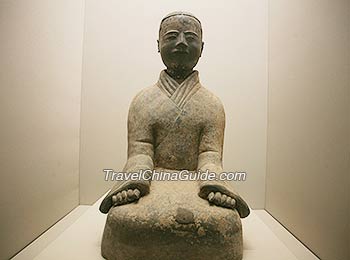 | | Rare Animal Feeder | | 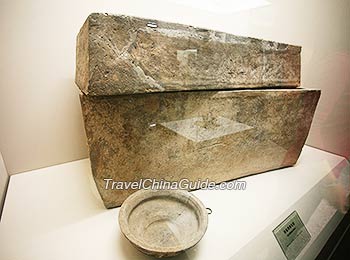 | | Coffins Used to Bury Rare Animals | |
 You may like:
You may like:
 Why are there partition walls in the pit of Terracotta Army?
Why are there partition walls in the pit of Terracotta Army?
 Recommended Tour Itinerary:
Recommended Tour Itinerary:
Terracotta Warriors Tour: One-day to visit Terracotta Warriors and Horses and more
More Xi'an Tours
 Next: Types of Terracotta Warriors
Next: Types of Terracotta Warriors
- Last updated on Aug. 14, 2024 by Catherine He -


![]() You may like:
You may like:![]() Why are there partition walls in the pit of Terracotta Army?
Why are there partition walls in the pit of Terracotta Army?![]() Recommended Tour Itinerary:
Recommended Tour Itinerary:![]() Next: Types of Terracotta Warriors
Next: Types of Terracotta Warriors




